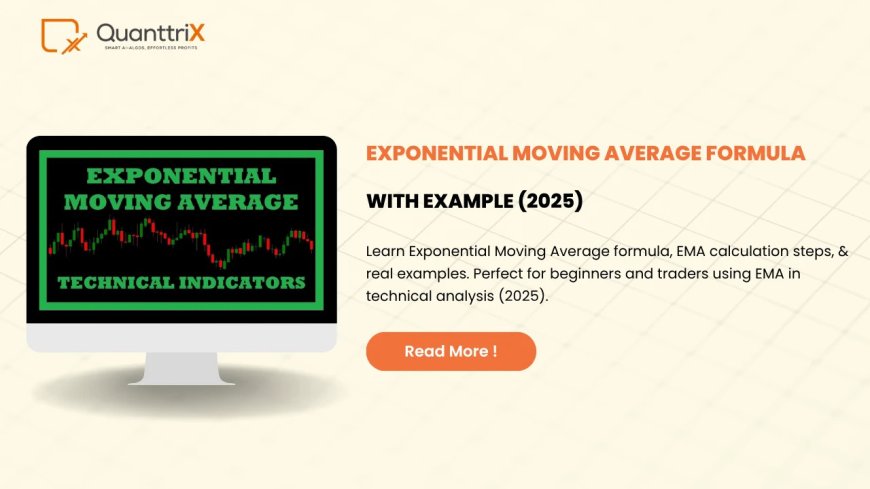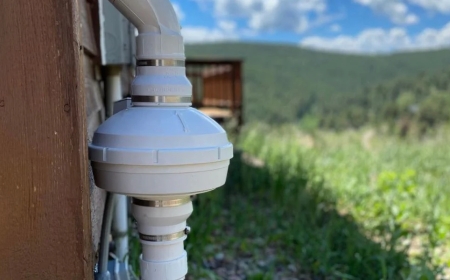Exponential Moving Average Formula Made Easy
Learn exponential moving average in simple terms. Discover its role in algo software, automated trading software & algorithmic trading software price.

Exponential Moving Average Formula: The Simplest Guide for Everyone
Introduction
Ever tried spotting patterns in the stock market? Its kind of like watching waves at the beach some are small and quick, others are long and powerful. Traders use something called the Exponential Moving Average (EMA) to track those waves. Whether youre just curious or diving into algo software or evaluating algorithmic trading software price, understanding EMA can be your golden key. Dont worry if youre not a math genius well break it down in plain, human-friendly language.
Learn exponential moving average in simple terms. Discover its role in algo software, automated trading software & algorithmic trading software price.
What is an Exponential Moving Average (EMA)?
EMA is a type of moving average that gives more weight to recent prices. Think of it as a way to track the most current trend of a stock, currency, or any traded asset. Unlike a Simple Moving Average (SMA), which treats all data points equally, EMA pays more attention to what's happening right now.
Why Do Traders Use EMA?
Traders love EMA because it reacts faster to price changes. Imagine driving a car SMA is like checking your average speed over a whole trip, while EMA is checking your current speed. Which one would you trust to avoid speeding? Yep, the EMA!
-
Faster signals for entry and exit
-
Better trend detection
-
Helps in algo software for real-time strategies
EMA vs. Simple Moving Average (SMA)
|
Feature |
EMA |
SMA |
|
Sensitivity |
More sensitive to recent data |
Less sensitive |
|
Reactiveness |
Quick to respond |
Slower response |
|
Usage |
Active traders, algo systems |
Long-term analysis |
Key Takeaway: Use EMA if you want a nimble, quick-response indicator.
The Exponential Moving Average Formula
Lets get to the formula but don't panic. Its easier than it looks:
EMA = [Close - EMA(previous day)] Multiplier + EMA(previous day)
Where:
-
Multiplier = 2 (N + 1)
-
N = Number of days (e.g., 10-day EMA)
So, for a 10-day EMA:
Multiplier = 2 (10 + 1) = 0.1818
EMA Calculation: Step-by-Step Example
Lets say you want to calculate the 10-day EMA of a stock. Heres how:
-
Start with a 10-day SMA as your first EMA.
-
Use the formula with each new days closing price.
-
Apply the multiplier to adjust the weighting.
Example:
-
Day 11 Close = ?102
-
Day 10 EMA = ?100
-
Multiplier = 0.1818
EMA = (102 - 100) 0.1818 + 100 = ?100.36
Each new day's EMA uses the previous day's EMA. Like a rolling snowball, it keeps growing and adapting.
How EMA Reacts to Market Movements
When the market moves suddenly:
-
EMA adjusts faster than SMA.
-
It captures short-term reversals, helping traders avoid late entries.
-
It's a favorite for automated trading software, as it helps systems "feel" the market.
EMA Settings: 9, 12, 26, 50, or 200?
Youve probably seen these numbers thrown around. Heres what they mean:
-
9-day/12-day EMA: For quick trades or short-term scalping.
-
26-day EMA: Good for mid-range trend spotting.
-
50-day EMA: Balances short and long-term signals.
-
200-day EMA: Trusted for big-picture decisions.
Tip: Use shorter EMAs for fast trades and longer ones for investment decisions.
EMA in Algo Software and Automated Systems
Modern algo software relies heavily on indicators like EMA. Why?
-
Real-time adaptability: EMA updates with every tick.
-
Fast execution: Algorithms dont wait they act.
-
Data-driven logic: EMA helps remove emotion from decisions.
If youre looking into automated trading software, check if it allows customizable EMA inputs.
How EMA Influences Automated Trading Software
EMA isnt just a pretty chart line its an action trigger.
Heres how it works:
-
When the short EMA crosses above a long EMA, the system buys (bullish signal).
-
When it crosses below, it sells (bearish signal).
This crossover technique is built into many algorithmic trading software platforms.
Key Insight: The algorithmic trading software price often depends on features like advanced EMA handling, backtesting, and custom triggers.
Real-Life Analogy: EMA as a Memory Filter
Imagine your brain could remember only the most recent and relevant things like forgetting old passwords but remembering your latest one. Thats EMA!
SMA = Like your memory of every past phone number.
EMA = Like your speed dial focused and current.
This analogy helps understand why traders love it: it keeps focus on what's important now.
EMA in Day Trading vs. Long-Term Investing
-
Day Traders: Use 5 to 20-period EMAs for scalping and intraday strategies.
-
Swing Traders: Prefer 20 to 50-period EMAs.
-
Investors: Trust the 100 or 200-day EMA for spotting market phases.
Best Practice: Match your EMA settings to your trading time frame.
Common Mistakes with EMA
Even a great tool like EMA can be misused:
-
Relying solely on EMA without other indicators
-
Over-optimizing (changing settings too often)
-
Ignoring market context EMA is a guide, not gospel
Pro Tip: Combine EMA with volume and price action for smarter decisions.
EMA + Other Indicators: A Smart Combo
EMA works best when paired with:
-
MACD (Moving Average Convergence Divergence)
-
RSI (Relative Strength Index)
-
Bollinger Bands
These combinations make your algo software smarter and more precise.
Choosing the Right Algorithmic Trading Tool
When picking automated trading software, look for:
-
EMA customization
-
Backtesting with EMA strategies
-
Real-time charting
-
User-friendly interface
-
Reasonable algorithmic trading software price
Some platforms even let you set triggers based on EMA crossovers.
Final Thoughts and Tips
EMA isnt just for pros. Its a beginner-friendly tool that becomes more powerful the more you use it. Whether you're trying to manually trade or automate your strategy through algo software, EMA is your friend.
-
Learn the basics
-
Practice with paper trading
-
Test with EMA settings
-
Integrate with automated systems
Trading without EMA is like driving without rearview mirrors you can do it, but why take the risk?
Conclusion
The Exponential Moving Average formula might sound technical, but at its heart, its just a smart way to follow trends and make better trading decisions. Whether you're exploring automated trading software, analyzing algorithmic trading software price, or just want to dip your toes into the markets, EMA is an essential tool that makes complex markets easier to understand.
Remember, its not about predicting the future its about following the trend with eyes wide open.
Frequently Asked Questions (FAQs)
1. What is the difference between EMA and SMA?
EMA gives more weight to recent prices, making it faster and more responsive than SMA, which treats all data points equally.
2. Is EMA suitable for beginner traders?
Yes, EMA is great for beginners because its easy to understand and very effective in spotting trends.
3. Can I use EMA in automated trading software?
Absolutely! Most modern algo software uses EMA as a key signal for entries and exits.
4. What is a good algorithmic trading software price to expect?
Prices vary from free to ?50,000+ depending on features like real-time data, EMA customization, and automation capabilities.
5. Which EMA settings work best?
It depends on your style short EMAs (9, 12) for quick trades, long EMAs (50, 200) for long-term investing.
































